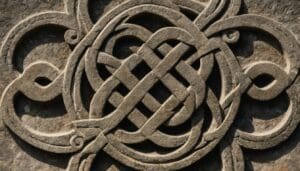20 Incredible Places to Visit in Fayoum
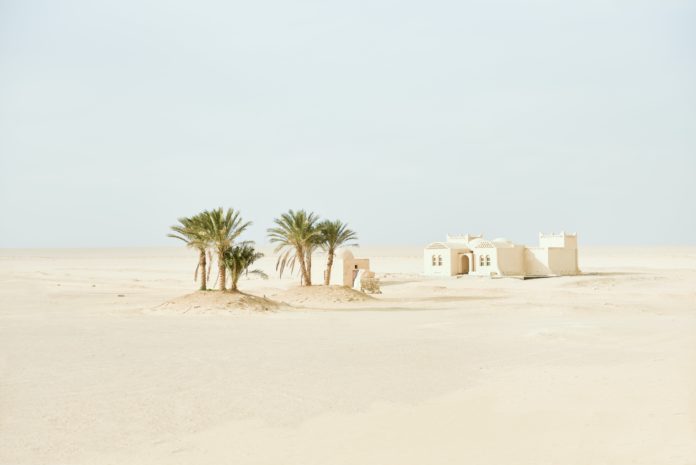
Updated On: April 18, 2024 by Ciaran Connolly
As one of Egypt’s oldest cities, Fayoum is not just filled with countless historical wonders but also many natural astonishments!
Located 100 km south of Cairo, you can get to Fayoum in only an hour and 15 minutes car ride. This city has the advantage of having moderate weather all year round. There are numerous places to visit in Fayoum. The city is home of many attractions belonging to diverse eras; such as the Pharaonic, Gerco-Roman, Coptic, and the Islamic.
Fayoum City was a region of ancient Egypt known for its fertility and the abundance of plants and animal life. Fayoum was once an arid desert basin then became a luxuriant oasis when a branch of the Nile deflected water into it. This attracted wildlife and encouraged plant growth which then attracted people to live in the area.
Check the history of this amazing city here!
Places to Visit in Fayoum
Fayoum has it all; remains of Ancient Egypt and the Roman Era, Coptic history and Ottoman monuments as well as nature preserves, lakes, mountains and fossils and let’s also not forget the different artistic activities it offers to the visitors. One would wonder, is Fayoum a real place? Yes, it is. And, while “you can’t have it all,” Fayoum can and actually does have it all.
The city of unspoiled nature and rich history is a place worth discovering. And as the question of “how do you spend a day in Fayoum” is asked by many, here are 20 attractions and places to visit in Fayoum.
Wadi El Rayan
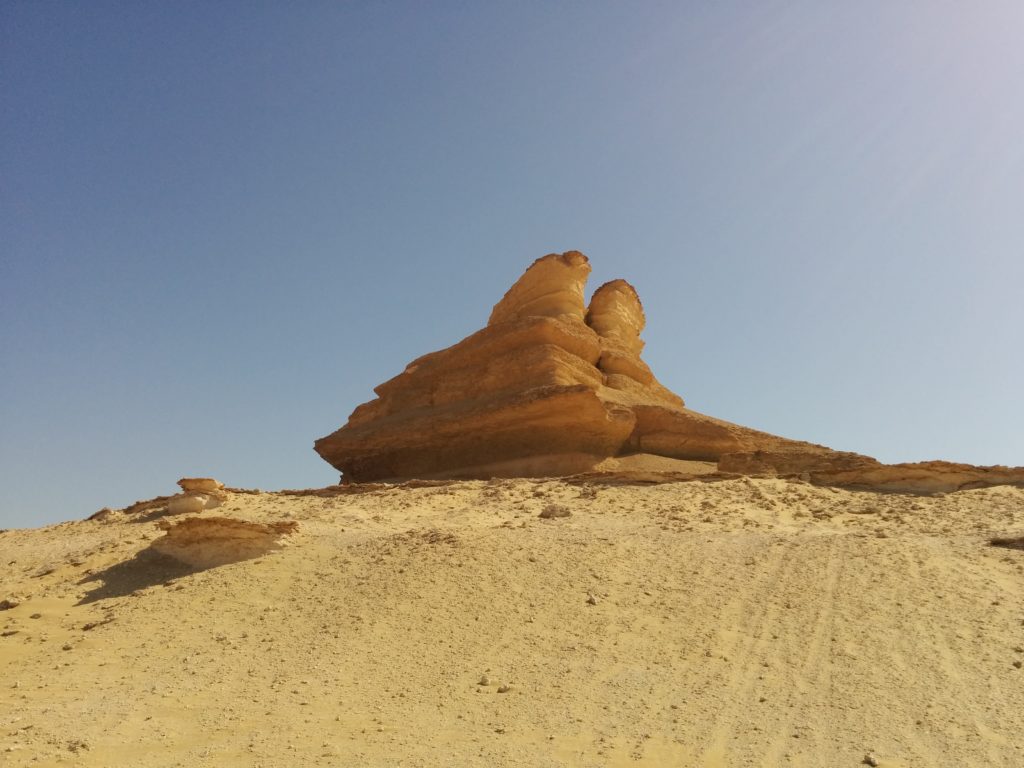
Wadi El Rayan is a nature reserve located 75 km from El Fayoum City. This reserve covers an area of 1759 km². It was announced as a protected area back in 1989. Wadi El Rayan is full of astonishing landscapes, oases, mountains, and rock formations. The area of Wadi El Rayan poses an interest for archaeologists and geologists as it is full of marine fossils and archaeological remains.
Wadi El Rayan consists of seven parts; the upper and lower lakes, El Rayan Springs, El Rayan Falls, El Modawara Mountain, El Rayan Mountain, as well as Wadi El-Hitan. Each part has its own beauty and uniqueness. Throughout its 1759 km², this reserve is the home of different wildlife species. These include white gazelles, Egyptian gazelles, sand foxes, fennec foxes in addition to many resident and migrant birds besides various types of eagles and falcons.
To give you all the information about visiting this astounding reserve, the entrance fees are $5/person. However, if you’d like to camp (yes, you can do that), the fees for camping is 200 EGP, which is around $12.72.
Fayoum’s Waterfall
The magic of Wadi El Rayan never fails to impress us. This nature reserve contains Egypt’s one and only waterfall. The waterfall is created because of the difference in height between the northern and southern lakes. You can find this waterfall15 km away from the reserve’s gate on the left side of the road.
Al Modawara Mountain
Another attraction that is worth visiting in Wadi El Rayan is Al Modawara Mountain. The mountain is located to the west of Al Fayoum Lake. It is more of a rock formation than an actual mountain and it has three peeking summits. The mountain is not too hard to climb and if you do so, you would be able to oversee the bewildering terrain of the whole area.
Qarun Lake
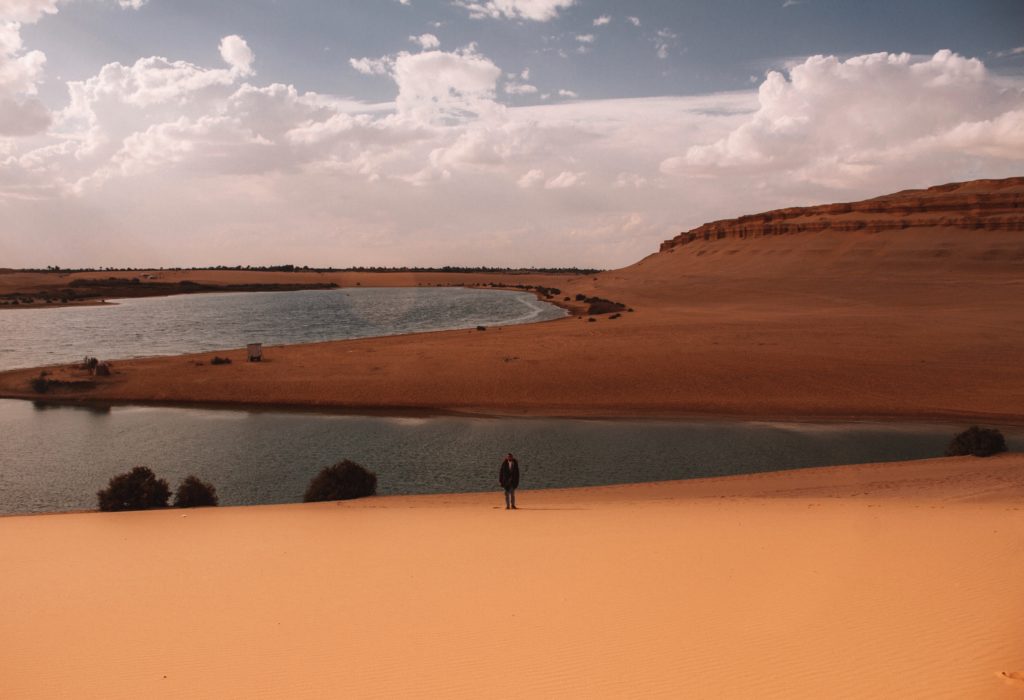
Qarun Lake, one of the most important ancient natural lakes, is located 20 km from Fayoum, and comprises 1155 km. The depth of the lake ranges from five meters in the east to thirteen in the west. The lake is actually the remaining part of an ancient lake called Moeris.
Lake Qarun is also internationally recognized as an “Important Bird Area,” where thousands of migratory birds rest during their winter migration pattern south. These unique qualities of the lake make it an ideal place to practice many sports, including fishing and bird watching. But Can you swim in Fayoum Lake of Qarun? Yes, you can. However, swimming is not advised from January to April due to cooler weather.
Qasr Qarun Temple
Qasr Qarun is a Ptolemaic temple that was built in 4 BC. This temple was dedicated to Sobek the crocodile headed god of Al Fayoum. It’s all that’s left from the ancient settlement that once stood there. The temple is 3-story high (around 13 meters) and a 180-m² piece of land. It’s located 65 km from Fayoum City at the western end of Lake Qarun, east of the village of Qasr Qarun.
Throughout the year, Qasr Qarun remains in absolute darkness except for the day of the 21st of December. On this day that marks the Winter Solstice, the sun aligns on the Holy of Holies of the temple where statues of Sobek where placed and worshipped.
You can visit this dazzling monument for only EGP 60 ($3.82) which is the fare for the ticket to enter the temple, and for even half that price if you are a student.
Hawara Pyramid
The village of Hawara, where the Pyramid of Hawara stands, is located 9 km from the city of Fayoum. The village has been known since ancient times and it was called Hat Wa’art, which means ‘the footsteps’.
The Pyramid of Hawara was made for Amenemhet III of the 12th Dynasty in ancient Egypt. It is located about 9 kilometers east of Fayoum Oasis. This Pyramid was built of brick stones and then covered by white white limestone. Unfortunately, nowadays only the brick core of the Pyramid remains. This is why it is sometimes called the black Pyramid.
The Pyramid of Hawara has a structure that is different from that of other Pyramids built in its era. It is believed to be influenced by the design of the step Pyramid of Saqqara. Furthermore, the entrance of the Pyramid is on the Southern section, unlike the other Pyramids that have their entrances in their Northern section.
However, to our disadvantage, not much remains of the structure of the Pyramid of Hawara except for the ground floor pillars and its underground floor is yet to be uncovered. While you can go and visit this Pyramid and see its surroundings, sadly, the interior of the Pyramid is now closed to visitors.
The Pyramid of Meidum
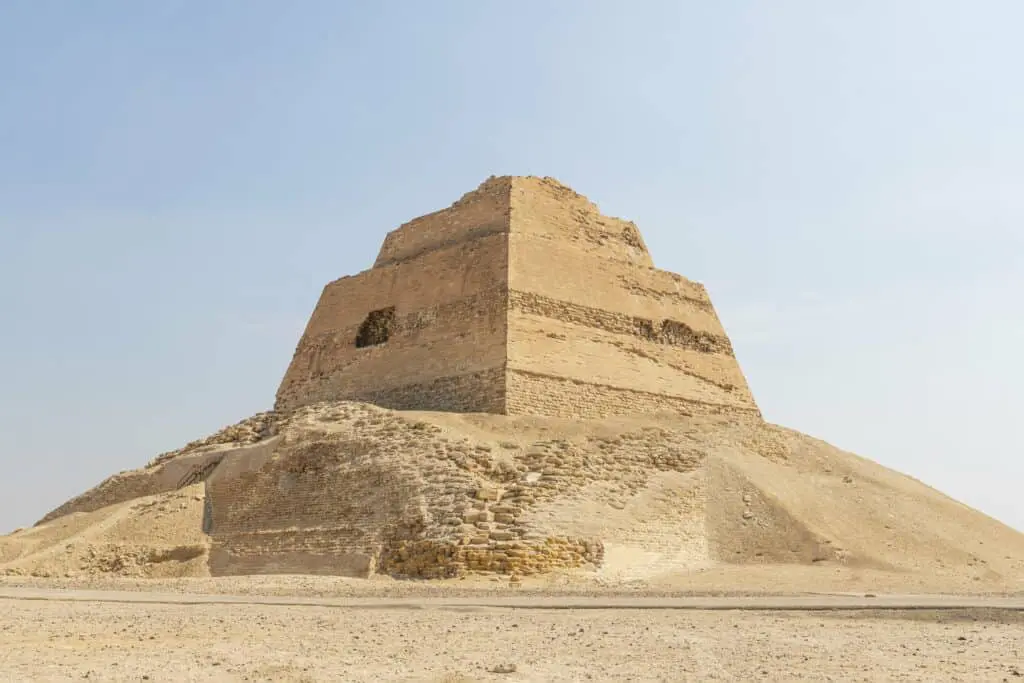
The Pyramid of Meidum is usually ascribed to Huni, the last king of the third dynasty even though his name does not appear anywhere in the Pyramid. This has led some to believe that it might have belonged to his son Sneferu whose name is in graffiti in a small temple at the site. It’s also thought that Huni might have begun the construction but Sneferu completed it since Sneferu already has two Pyramid complexes at Dahshur.
The Pyramid of Meidum started as a step Pyramid then was converted into a true one. Located 30 km from the city of Fayoum, this Pyramid marks the transition from the Early Dynastic Period to the Old Kingdom. Being the first true attempt of ancient Egyptians to build a Pyramid, the Pyramid of Meidum had many design flaws. This caused the sides of the Pyramid to collapse sometime after its completion. Nowadays, only the core stands but it is still a wonderful sight to behold.
When you visit, the guard will open the entrance of the Pyramid. There will be steps leading 75 m down to the burial chamber. Near the Pyramid, there are large mastaba tombs of some of Sneferu’s family and officials.
If you decide to visit this amazing monument, do not take public transportation as the place is not easy to find. Your best option is to take a taxi.
Lahun Pyramid
The Pyramid of Lahun was established 4000 years ago by the 12th dynasty pharaoh Sensret II. Just like the Pyramid of Meidum, this Pyramid has its entrance located in the Southern side. This makes them peculiar as Egypt’s other Pyramids typically have entrances on their Northern side.
The Pyramid of Lahun is located on a 12 meter hill 22 km away from the Fayoum governorate. It was discovered in 1889 by British archaeologist William Petrie. The Pyramid has been restored recently by the Egyptian authority and was opened to the public for the first time in June 2019.
Fayoum Waterwheels
If you are into rural tourism, this attraction is made just for you!
Fayoum City has more than 200 waterwheels scattered all over its depression. Made of white wood called ‘Azizy’, these waterwheels have kept Fayoum’s cultivated lands well-irrigated since the Gerco Roman Era. The wheels are non-stop as the force of the river stream drives through the broad paddles. The boxes in the edge fill with water, pick it up and pour it out of the holes at their sides as they reach the top, into a pipe that takes the water out to the fields.
While Fayoum is known for many things, if we answer the question of “What is Fayoum known for?,” we would simply say, its waterwheels. Fayoum’s many waterwheels are one of the city’s unique sights. The city is so popular for having these non-stop waterwheels to the extent that the city’s symbol is seven black waterwheels. The largest of these wheels is located in Basiouniya village, 14 km east of Fayoum. This waterwheel provides fresh water for 37 hectares of cultivated lands.
The city’s biggest waterwheel is maintained annually in mid January, when the flow is at its lowest. Each six years, this wheel is changed in a celebration attended by the people of the village.
The famous waterwheels of Fayoum city can be seen as you stroll through this beautiful city.
Fayoum’s Petrified Forest
Fayoum’s Petrified Forest is located 30 km from Cairo. It is at least 35 million years old. The Forest lies on 7 km², and is covered with remains of trees. The remains were actually brought to the area because of the floods that used to happen on the red sea hills.
Because of its importance as an example of the physical history of the earth, the Petrified Forest was declared a protectorate in 1989. The natural treasures of the place make it a cultural, touristic, and scientific destination.
This place is suitable for you if you are a nature lover. If you are not, don’t go. As all what you can see there is nature related sights of stones, sands, and rocks.
Wadi El-Hitan ‘The Valley of the Whales’
Wadi El-Hitan is located in the Western Desert of Egypt. As its name suggests, the valley has a lot to do with whales. It is the only place in the whole entire world where one can observe the skeletons of families of archaic whales in their original environment.
Wadi El-Hitan is marked by a rich content of vertebrate and invertebrate fossils. The whale fossils found in the valley help answer important questions about evolution.
However, the valley has even more to offer! It has recently become a popular destination to stargazers who seek clear skies to be able to look at the magnificent stars. So, if you’re looking for a trip to relax and unwind, here’s your destination.
Magic Lake
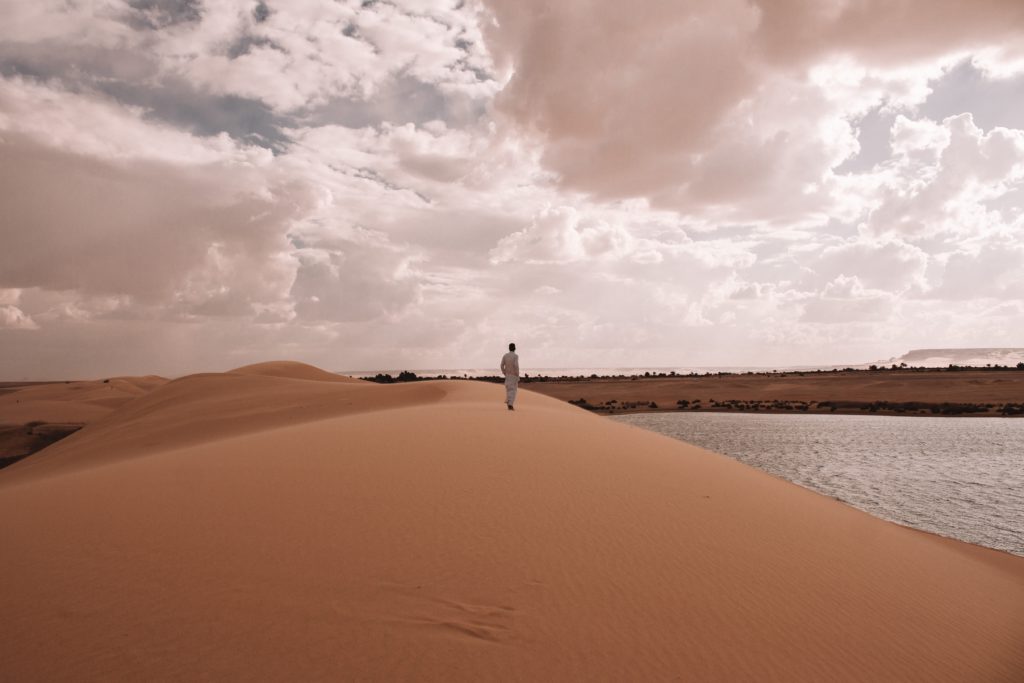
Are you big on physical activities? This place has it all. Aquasports or just sports, they are both available right by the Magic Lake. Here, you can go swimming or sandboarding and if you get tired, you can rest a little right beside Fayoum’s amazing waterfall.
The magic lake is an exquisite hidden lake located in Wadi El-Hitan in Fayoum. The lake has its name from the fact that it changes colors according to the time of the day and the amount of sunrise seeping through it.
Karanis Open-Air Museum
Into ancient history? This is for you!
The open-air museum of Karanis is located at the edge of Fayoum Oasis inside of Karanis archaeological site. The place is exactly 35 km north of Fayoum City.
This museum displays fragments of monumental architectural pieces and stone sculptures from pharaonic times. Among the displayed objects are some physical remnants of the once important city of Crocodilopolis.
Fossil & Climate Change Museum
From showing ancient history to educating people about modern concerns, this museum in Fayoum combines them both!
This museum is the first in the Middle East that is dedicated to displaying fossils. The centerpiece of the museum is an 18-metre long skeleton of a Basilosaurus Isis whale. The museum also shows the role of climate change in completely altering the area of Wadi El-Hitan.
If you have a ticket for Wadi El-Hitan, you can enter the museum for no extra fees.
Madinet Madi
The archaeological site of Madinet Madi is located at a strategic position as guarding the city. The site is 35 km away from Fayoum city. The name of the city has changed many times. Its current name is believed to be taken from Arabic ‘Madi’ to mean past. So, it’s the city of the past.
The most important temple of the site is that of the cobra-goddess Renenutet. This temple was founded during the reigns of Amenemhat III and Amenemhat IV. It was then expanded during the Greco-Roman period.
Recently, the Egyptian Authority renovated the site, adding a visitor center and Eco-lodge so visitors could rest a little or even spend the night near the ruins of the ancient city. To enter the site, you’ll need to get a ticket for EGP 50 ($3.18), and a 50% discount is offered to students.
OBELISK OF SENUSRET I
OBELISK OF SENUSRET I is a 13-meter high pharaonic monument placed at the northern entrance of Fayoum city. However, the entrance of the city is not the place at which this monument was originally erected. Its original place was a village called Abgig a few kilometers away from the Fayoum City.
You can simply see the monument as you pass by.
Qasr El Sagha Temple
This temple is hidden in the desert north of Qarun Lake. It is a small, rectangle-shaped, uninscribed temple, known locally as Qasr El-Sagha. The Temple of Qasr El Sagha is built of huge blocks of local sandstone in unequal sizes.
The temple has seven small chambers and a blind room that appears to have no entrance. The date in which the temple was built is up for debate. The temple was never completed and its walls were left undecorated.
The temple has no fees to enter!
The Hanging Mosque
Let’s take a break from the different fossils and ancient Egyptian monuments to move to Ottoman history. This Hanging Mosque was built by prince Soliman Ibn Hatem in 1560. It is located on Port Said street, the largest street in Fayoum city.
The mosque is described as ‘hanging’ because it was built on a high hill and under it were shops. The ceiling of the mosque is rich with writing inscriptions and decorations.
Tunis Village
Tunis village is located in the oasis of Fayoum, on the way to Wadi Rayan just a two-hour drive from downtown Cairo. The village overlooks a salted lake and is one of the most beautiful villages in Egypt.
Until recently, the village of Tunis was an unknown fishing community. But Tunis has its own charm; tiny, stunning and unbelievably peaceful. The fame of the village comes from its gorgeous pottery production.
It all started in the 1980s when Evelyn Porret, a Swiss female potter visited the village with her Egyptian friends. It wasn’t long until she decided to build her country house in Tunis and move there for good. She then opened a pottery studio in her house where she taught the craft to many of the residents.
As a tourist/visitor, you also can sharpen your pottery skills when you go to Tunis village as they offer pottery making activities to all visitors. Just for EGP 20 ($1.27) per person, you can enter the beautiful village of Tunis.
Caricature Museum
The Caricature Museum is the first of its kind in the Middle East. It was established in 2010 by Caricature Artist Mohamed Abla as a part of the Fayoum Art Center. Abla chose the village of Tunis that is 60 km out of Fayoum to be the home of his unique museum. The museum is only a few steps away from the village’s entrance and is known for being a place for creativity.
The museum is built of yellow stones and has a dome-like ceiling. It is surrounded by trees and flowers that add to its artistic being.
Here you have it. Activities that suit each and every one! They can be done if you are visiting alone, with friends or even family. Some of these would take a full day while others can be done in just a few hours which is the beauty of this diverse city.


